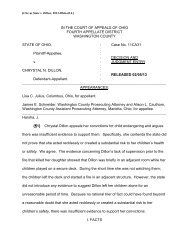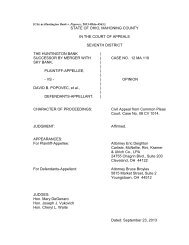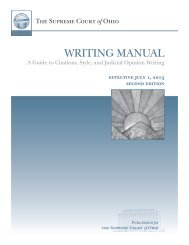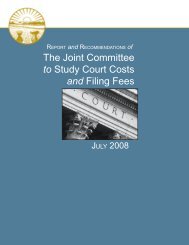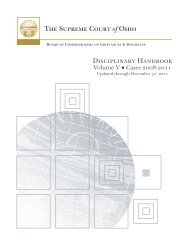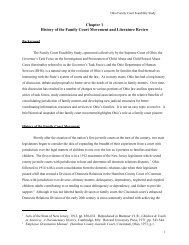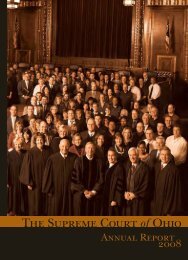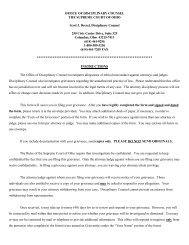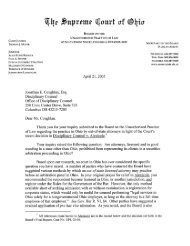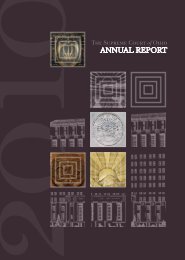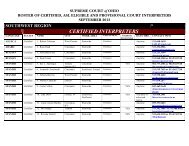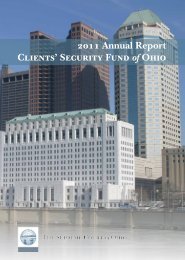The Supreme Court of Ohio & The Ohio Judicial System
The Supreme Court of Ohio & The Ohio Judicial System
The Supreme Court of Ohio & The Ohio Judicial System
Create successful ePaper yourself
Turn your PDF publications into a flip-book with our unique Google optimized e-Paper software.
<strong>The</strong> <strong>Supreme</strong> <strong>Court</strong><br />
<strong>of</strong> <strong>Ohio</strong><br />
& THE<br />
OHIO JUDICIAL SYSTEM
INTRODUCTION<br />
<strong>The</strong> Constitution <strong>of</strong> <strong>Ohio</strong> separates our state government into three branches, each with<br />
distinct areas <strong>of</strong> responsibility — the executive, the legislative and the judicial.<br />
<strong>The</strong> primary function <strong>of</strong> the judicial branch is to fairly and impartially settle disputes<br />
according to the law. To do this, a number <strong>of</strong> courts have been established in the state by the<br />
Constitution and by acts <strong>of</strong> the General Assembly.<br />
In addition to its place in the court structure as the court <strong>of</strong> last resort, the <strong>Supreme</strong> <strong>Court</strong>,<br />
in particular the Chief Justice, is responsible for the administration <strong>of</strong> the judicial branch<br />
in <strong>Ohio</strong>.<br />
In the belief that people’s confidence in their courts is enhanced when they understand how the<br />
courts function and how the courts affect them, this booklet has been prepared and made available<br />
to you.<br />
<strong>The</strong> <strong>Supreme</strong> <strong>Court</strong> <strong>of</strong> <strong>Ohio</strong><br />
Maureen O’Connor<br />
Chief Justice<br />
Paul E. Pfeifer<br />
Terrence O’Donnell<br />
Judith Ann Lanzinger<br />
Sharon L. Kennedy<br />
Judith L. French<br />
William M. O’Neill<br />
Justices<br />
Steven C. Hollon<br />
Administrative Director
THE SUPREME COURT OF OHIO<br />
<strong>The</strong> <strong>Supreme</strong> <strong>Court</strong> <strong>of</strong> <strong>Ohio</strong> is established by Article<br />
IV, Section 1, <strong>of</strong> the <strong>Ohio</strong> Constitution, which provides<br />
that “the judicial power <strong>of</strong> the state is vested in a<br />
<strong>Supreme</strong> <strong>Court</strong>, <strong>Court</strong>s <strong>of</strong> Appeals, <strong>Court</strong>s <strong>of</strong> Common<br />
Pleas and divisions there<strong>of</strong>, and such other courts<br />
inferior to the <strong>Supreme</strong> <strong>Court</strong> as may from time to time<br />
be established by law.”<br />
Article IV, Section 2, <strong>of</strong> the<br />
Constitution sets the size <strong>of</strong> the<br />
<strong>Court</strong> at seven – a Chief Justice<br />
and six Justices – and outlines<br />
the jurisdiction <strong>of</strong> the <strong>Court</strong>.<br />
<strong>The</strong> <strong>Supreme</strong> <strong>Court</strong> is the<br />
court <strong>of</strong> last resort in <strong>Ohio</strong>. Most<br />
<strong>of</strong> its cases are appeals from the<br />
12 district courts <strong>of</strong> appeals.<br />
<strong>The</strong> <strong>Court</strong> may grant leave to<br />
appeal criminal cases from the<br />
courts <strong>of</strong> appeals and may direct<br />
any court <strong>of</strong> appeals to certify<br />
its record on civil cases that are<br />
found to be “cases <strong>of</strong> public or<br />
great general interest.”<br />
<strong>The</strong> <strong>Court</strong> must accept<br />
appeals <strong>of</strong> cases that originated<br />
in the courts <strong>of</strong> appeals; cases<br />
involving the death penalty;<br />
cases involving questions arising<br />
under the U.S. Constitution<br />
or the <strong>Ohio</strong> Constitution; and<br />
(ordering a lower court to cease an unlawful act), and<br />
writs <strong>of</strong> quo warranto (against a person or corporation<br />
for usurpation, misuse or abuse <strong>of</strong> public <strong>of</strong>fice or<br />
corporate <strong>of</strong>fice or franchise).<br />
<strong>The</strong> <strong>Court</strong> may also grant leave to appeal a case<br />
involving a contested election. This type <strong>of</strong> a case is<br />
unique because it is the only type <strong>of</strong> discretionary<br />
appeal that permits a case to be taken directly from the<br />
court <strong>of</strong> common pleas to the<br />
<strong>Supreme</strong> <strong>Court</strong>, bypassing the<br />
court <strong>of</strong> appeals.<br />
<strong>The</strong> <strong>Supreme</strong> <strong>Court</strong> makes<br />
rules governing practice and<br />
procedure in <strong>Ohio</strong>’s courts,<br />
such as the Rules <strong>of</strong> Evidence,<br />
Rules <strong>of</strong> Civil Procedure and<br />
Rules <strong>of</strong> Criminal Procedure.<br />
Procedural rules adopted by<br />
the <strong>Supreme</strong> <strong>Court</strong> become<br />
effective unless both houses <strong>of</strong><br />
the General Assembly adopt<br />
a concurrent resolution <strong>of</strong><br />
disapproval. <strong>The</strong> <strong>Supreme</strong><br />
<strong>Court</strong> also exercises general<br />
superintendence over all<br />
state courts through its<br />
rule-making authority. <strong>The</strong><br />
rules <strong>of</strong> superintendence set<br />
minimum standards for court<br />
administration statewide.<br />
Unlike procedural rules, rules<br />
cases in which there have been<br />
conflicting opinions from two or<br />
more courts <strong>of</strong> appeals.<br />
<strong>The</strong> <strong>Supreme</strong> <strong>Court</strong> <strong>of</strong> <strong>Ohio</strong> is established<br />
by the state Constitution.<br />
<strong>of</strong> superintendence do not<br />
have to be submitted to the<br />
General Assembly to become<br />
<strong>The</strong> <strong>Court</strong> must also accept appeals from such<br />
administrative bodies as the Board <strong>of</strong> Tax Appeals and<br />
the Public Utilities Commission.<br />
<strong>The</strong> <strong>Court</strong> has original jurisdiction for certain<br />
special remedies that permit a person to file an action<br />
in the <strong>Supreme</strong> <strong>Court</strong>. <strong>The</strong>se extraordinary remedies<br />
include writs <strong>of</strong> habeas corpus (involving the release <strong>of</strong><br />
persons allegedly unlawfully imprisoned or committed),<br />
writs <strong>of</strong> mandamus and procedendo (ordering a public<br />
<strong>of</strong>ficial to do a required act), writs <strong>of</strong> prohibition<br />
effective.<br />
<strong>The</strong> Chief Justice assigns judges to courts for<br />
temporary duty in cases <strong>of</strong> a court overload, where<br />
a judge has been removed from a case because <strong>of</strong><br />
an affidavit <strong>of</strong> disqualification, or where a judge has<br />
recused himself or herself from a particular case.<br />
<strong>The</strong> <strong>Court</strong> has authority over the admission <strong>of</strong><br />
attorneys to the practice <strong>of</strong> law in <strong>Ohio</strong> and may<br />
discipline admitted attorneys who violate the rules<br />
governing the practice <strong>of</strong> law.<br />
3
<strong>The</strong> Chief Justice and six Justices are elected to<br />
six-year terms on a nonpartisan ballot. Two Justices are<br />
chosen at the general election in even-numbered years.<br />
In the year when the Chief Justice is on the ballot, voters<br />
elect three members <strong>of</strong> the <strong>Court</strong>. A person must be<br />
an attorney with at least six years <strong>of</strong> experience in the<br />
practice <strong>of</strong> law to be elected or appointed to the <strong>Court</strong>.<br />
Appointments are made by the governor for vacancies<br />
that occur between elections.<br />
HOME OF THE COURT<br />
<strong>The</strong> <strong>Supreme</strong> <strong>Court</strong> is housed in the Thomas J. Moyer<br />
<strong>Ohio</strong> <strong>Judicial</strong> Center at 65 South Front Street in<br />
Columbus. This historic landmark consolidates the<br />
<strong>Court</strong>, its affiliated <strong>of</strong>fices and other <strong>of</strong>fices in the<br />
judicial branch, including the:<br />
Board <strong>of</strong> Commissioners on Grievances<br />
& Discipline;<br />
Clients’ Security Fund;<br />
<strong>Ohio</strong> <strong>Court</strong> <strong>of</strong> Claims;<br />
<strong>Ohio</strong> Criminal Sentencing Commission; and<br />
<strong>Ohio</strong> <strong>Judicial</strong> Conference.<br />
<strong>The</strong> move <strong>of</strong> the <strong>Court</strong> and these <strong>of</strong>fices in February<br />
2004 to the Moyer <strong>Judicial</strong> Center marked a historic<br />
change in <strong>Ohio</strong>: For the first time in the state’s 200-year<br />
history, the judicial branch<br />
has quarters separate from<br />
the other two branches<br />
<strong>of</strong> <strong>Ohio</strong> government,<br />
emphasizing its unique<br />
and independent role in<br />
state government.<br />
Built in the 1930s, the<br />
building was meticulously<br />
restored and renovated<br />
at less than half the<br />
cost <strong>of</strong> building a new<br />
<strong>The</strong> Thomas J. Moyer <strong>Ohio</strong> <strong>Judicial</strong> facility. Unlike modern<br />
Center was completed in the 1930s. buildings, original artwork<br />
is integrated on the<br />
building’s exterior and interior. Many public spaces<br />
have their own theme relating to <strong>Ohio</strong>’s rich history.<br />
<strong>The</strong> Civic Center Drive level pays tribute to the first<br />
<strong>Ohio</strong>ans – the Native Americans – with bronze panels<br />
<strong>of</strong> Little Turtle, Logan, Pontiac and Tecumseh. Native<br />
American influence also can be seen in the tiled ceiling<br />
mosaics and bronze details on the light fixtures, doors<br />
and elevator panels.<br />
<strong>The</strong> Grand Concourse<br />
on the Front Street level<br />
honors political leaders<br />
from <strong>Ohio</strong> with bronze<br />
bas relief portraits <strong>of</strong> two<br />
speakers <strong>of</strong> the U.S. House <strong>of</strong><br />
Representatives, eight U.S.<br />
presidents and nine U.S.<br />
<strong>Supreme</strong> <strong>Court</strong> justices.<br />
<strong>The</strong> most impressive<br />
space in the building is the<br />
courtroom on the Front<br />
Street level. It is nearly twostories<br />
high, with several<br />
Moyer <strong>Judicial</strong> Center in Columbus.<br />
State flags fly opposite the<br />
70-year-old murals depicting<br />
the history <strong>of</strong> <strong>Ohio</strong> and the Northwest Territory. At the<br />
north end sits a massive hand-carved walnut bench with<br />
10 iconic images that tell the story <strong>of</strong> <strong>Ohio</strong>’s judiciary.<br />
For more information and photos <strong>of</strong> the building,<br />
visit www.supremecourt.ohio.gov.<br />
HEARING A CASE<br />
At exactly 9 a.m., the marshal <strong>of</strong> the <strong>Supreme</strong> <strong>Court</strong><br />
asks the attorneys and spectators to rise and announces:<br />
<strong>The</strong> honorable Chief Justice and Justices<br />
<strong>of</strong> the <strong>Supreme</strong> <strong>Court</strong> <strong>of</strong> <strong>Ohio</strong>.<br />
Members <strong>of</strong> the <strong>Court</strong> file in and take their places<br />
behind the walnut bench. <strong>The</strong> Chief Justice is in the<br />
center with three Justices on either side. <strong>The</strong> most<br />
senior Justices sit nearest the center <strong>of</strong> the bench.<br />
<strong>The</strong> members <strong>of</strong> the <strong>Court</strong> remain standing as the<br />
marshal opens court.<br />
Hear Ye! Hear Ye! Hear Ye! <strong>The</strong> honorable<br />
<strong>Supreme</strong> <strong>Court</strong> <strong>of</strong> <strong>Ohio</strong> is now in open session<br />
pursuant to adjournment.<br />
4
<strong>The</strong> Chief Justice<br />
announces the first<br />
case and the name<br />
<strong>of</strong> the attorney who<br />
will make the first<br />
presentation. <strong>The</strong><br />
attorney walks to the<br />
lectern in front <strong>of</strong> the<br />
bench and begins the<br />
argument. Normally,<br />
arguments are limited<br />
to 15 minutes per side,<br />
Normally, arguments are limited<br />
but in some cases the<br />
to 15 minutes per side.<br />
time is increased to 30<br />
minutes.<br />
<strong>The</strong> marshal keeps track <strong>of</strong> the time and turns on<br />
a white light on the lectern when the attorney has two<br />
minutes <strong>of</strong> time remaining. A red light indicates when<br />
the time has expired.<br />
Prior to the arguments, members <strong>of</strong> the <strong>Court</strong> read<br />
summaries <strong>of</strong> the case and briefs <strong>of</strong> the legal arguments<br />
<strong>of</strong> each side. <strong>The</strong> oral presentations <strong>of</strong> attorneys are<br />
<strong>of</strong>ten marked by sharp questioning from the bench.<br />
All oral arguments before the <strong>Court</strong> are televised<br />
live by <strong>Ohio</strong> Government Telecommunications on the<br />
<strong>Ohio</strong> Channel. Live streaming video and a video archive<br />
<strong>of</strong> all <strong>of</strong> the <strong>Court</strong>’s oral argument sessions since March<br />
2004 can be viewed on the <strong>Court</strong>’s website at www.<br />
supremecourt.ohio.gov/<br />
videostream/oarg_video/default.asp.<br />
<strong>The</strong> <strong>Court</strong> generally hears four or five cases in a<br />
day. When the final argument has been given in the last<br />
case on the day’s docket, the marshal asks those in the<br />
courtroom to rise and announces:<br />
Hear Ye! Hear Ye! Hear Ye! This open session <strong>of</strong><br />
the honorable <strong>Supreme</strong> <strong>Court</strong> <strong>of</strong> <strong>Ohio</strong> now stands<br />
adjourned.<br />
DECIDING A CASE<br />
<strong>The</strong> Justices file out and go to the deliberation room to<br />
discuss the cases that have been heard. <strong>The</strong> only person<br />
with them in the deliberation room is the reporter <strong>of</strong><br />
decisions, who records the Justices’ votes.<br />
<strong>The</strong> Chief Justice calls on each Justice to present his<br />
or her view <strong>of</strong> the case. In cases where one <strong>of</strong> the Justices<br />
recuses himself or herself from hearing a case, a judge<br />
<strong>of</strong> one <strong>of</strong> the courts <strong>of</strong> appeals is assigned by the Chief<br />
Justice to sit on the <strong>Supreme</strong> <strong>Court</strong>. If the Chief Justice<br />
does not participate, the most senior Justice sits as acting<br />
Chief Justice.<br />
It takes at least four votes to decide a case. When<br />
the vote has been taken, small balls with numbers<br />
representing the Justices who voted with the majority<br />
are put in a leather bottle. <strong>The</strong> senior Justice shakes<br />
the bottle and pours out one ball. Another Justice looks<br />
at the ball and announces who has been selected to<br />
write the opinion <strong>of</strong> the court in the case. That ball is<br />
not put back in the bottle until each <strong>of</strong> the Justices has<br />
been assigned the<br />
writing <strong>of</strong> a case.<br />
<strong>The</strong> writing <strong>of</strong> the<br />
opinions is done by<br />
random selection<br />
and the workloads<br />
<strong>of</strong> the Chief Justice<br />
and Justices are<br />
nearly equal.<br />
When the<br />
majority opinion<br />
<strong>The</strong> Justices vote on cases in the<br />
is written, it is<br />
deliberation room.<br />
circulated to<br />
members <strong>of</strong> the <strong>Court</strong> for comment. Members in the<br />
majority may choose to write a concurring opinion.<br />
Those in dissent may prepare a dissenting opinion.<br />
Opinions are announced on Wednesday — except for<br />
some special releases — and become the governing law<br />
throughout the state.<br />
<strong>The</strong> <strong>Ohio</strong> Constitution requires all actions <strong>of</strong><br />
the <strong>Supreme</strong> <strong>Court</strong> to be published. <strong>The</strong>re are no<br />
“unreported decisions.” Several days after being issued,<br />
the opinions are printed in the <strong>Ohio</strong> Official Reports<br />
Advance Sheets. <strong>The</strong>y are later issued in bound volumes<br />
<strong>of</strong> the <strong>Ohio</strong> Official Reports and in the North Eastern<br />
Reporter. <strong>The</strong>se volumes are available in law libraries<br />
throughout the state, the nation and the world.<br />
5
THE SUPREME COURT OF OHIO:<br />
HISTORICAL PERSPECTIVE<br />
<strong>The</strong> history <strong>of</strong> the <strong>Supreme</strong> <strong>Court</strong> <strong>of</strong> <strong>Ohio</strong> begins with<br />
the history <strong>of</strong> our state.<br />
When <strong>Ohio</strong> was carved out <strong>of</strong> the Northwest<br />
Territory and its first Constitution adopted in 1802, the<br />
<strong>Supreme</strong> <strong>Court</strong> <strong>of</strong> <strong>Ohio</strong> was established as the highest<br />
court <strong>of</strong> the state. That Constitution, which provided for<br />
a <strong>Court</strong> consisting <strong>of</strong> three judges, required a<br />
session <strong>of</strong> the <strong>Supreme</strong> <strong>Court</strong> to be held each year in<br />
every county <strong>of</strong> the state.<br />
Those early judges spent a major portion <strong>of</strong> their<br />
time riding horseback throughout the state. <strong>The</strong>y were<br />
usually accompanied by members <strong>of</strong> the bar who went<br />
along to present the cases to the <strong>Court</strong>. <strong>The</strong> judges, in<br />
order to make room in their saddlebags for fresh linen,<br />
carried very few law books with them. <strong>The</strong>y carried most<br />
<strong>of</strong> the law in their heads. Many <strong>of</strong> their early sessions<br />
were not held in the Statehouse — or even a courthouse<br />
— but were held in the homes <strong>of</strong> various individuals in<br />
the counties.<br />
From those early days until the amendment <strong>of</strong><br />
the Constitution in 1912, the number <strong>of</strong> judges on<br />
the <strong>Supreme</strong> <strong>Court</strong> varied from three to six. By the<br />
amendment in 1912, however, the membership <strong>of</strong> the<br />
<strong>Court</strong> was fixed at seven, composed <strong>of</strong> a Chief Justice<br />
and six judges. That is the present size <strong>of</strong> the court. In<br />
1968, the Constitution was further amended to identify<br />
each <strong>of</strong> the other six judges as Justice.<br />
Ross County <strong>Court</strong>house<br />
Chillicothe<br />
COURTS OF<br />
APPEALS<br />
<strong>The</strong> courts <strong>of</strong><br />
appeals are<br />
established by<br />
Article IV, Section<br />
1, <strong>of</strong> the <strong>Ohio</strong><br />
Constitution and<br />
their jurisdiction is<br />
outlined in Article<br />
IV, Section 3. As<br />
the intermediate<br />
level appellate<br />
courts, their<br />
primary function is to hear appeals from the common<br />
pleas, municipal and county courts. Each case is heard<br />
and decided by a three-judge panel.<br />
<strong>The</strong> state is divided into 12 appellate districts,<br />
each <strong>of</strong> which is served by a court <strong>of</strong> appeals. <strong>The</strong><br />
number <strong>of</strong> judges in each district depends on a variety<br />
<strong>of</strong> factors, including the district’s population and the<br />
court’s caseload. Each district has a minimum <strong>of</strong> four<br />
appellate judges. Appeals court judges are elected to<br />
six-year terms in even-numbered years. <strong>The</strong>y must have<br />
been admitted to the practice <strong>of</strong> law in <strong>Ohio</strong> six years<br />
preceding commencement <strong>of</strong> the term.<br />
In addition to their appellate jurisdiction, the courts<br />
<strong>of</strong> appeals have original jurisdiction, as does the<br />
<strong>Supreme</strong> <strong>Court</strong>, to hear applications for writs <strong>of</strong> habeas<br />
corpus, mandamus, procedendo, prohibition and quo<br />
warranto. <strong>The</strong> 10 th District <strong>Court</strong> <strong>of</strong> Appeals in Franklin<br />
County also hears appeals from the <strong>Ohio</strong> <strong>Court</strong> <strong>of</strong><br />
Claims.<br />
THE COURT OF CLAIMS<br />
<strong>The</strong> <strong>Court</strong> <strong>of</strong> Claims has original jurisdiction to hear<br />
and determine all civil actions filed against the state<br />
<strong>of</strong> <strong>Ohio</strong> and its agencies. <strong>The</strong> court also hears appeals<br />
from decisions made by the attorney general on claims<br />
allowed under the Victims <strong>of</strong> Crime Act.<br />
<strong>The</strong> <strong>Court</strong> <strong>of</strong> Claims decides civil claims typically<br />
involving contract disputes, property damage, personal<br />
injury, immunity <strong>of</strong> state<br />
<strong>of</strong>ficers and employees, discrimination and wrongful<br />
imprisonment. <strong>The</strong> Chief<br />
Justice assigns judges to hear<br />
such cases. In almost every<br />
instance, a single judge will<br />
hear a case, but the Chief<br />
Justice may assign a panel<br />
<strong>of</strong> three judges to a civil<br />
action that presents novel<br />
or complex issues <strong>of</strong> law and<br />
fact.<br />
Civil complaints filed for<br />
$2,500 or less are decided<br />
on the contents <strong>of</strong> the case<br />
file or “administratively” by<br />
<strong>Ohio</strong> <strong>Court</strong> <strong>of</strong> Claims <strong>Court</strong>room<br />
Moyer <strong>Judicial</strong> Center<br />
6
the clerk or a deputy clerk <strong>of</strong> the court. Appeals from<br />
those decisions (“administrative determinations”) may<br />
be taken to a judge <strong>of</strong> the court upon motion for court<br />
review. <strong>The</strong> court’s judgment is not subject to further<br />
appeal.<br />
Appeals filed by crime victims are heard and<br />
determined by a panel <strong>of</strong> three commissioners who<br />
are appointed by the <strong>Supreme</strong> <strong>Court</strong> for a term <strong>of</strong><br />
six years. A further and final appeal from the panel’s<br />
decision may be taken to a judge <strong>of</strong> the court. Like<br />
administrative determinations, the judge’s decision is<br />
final.<br />
COURTS OF COMMON PLEAS<br />
<strong>The</strong> court <strong>of</strong> common pleas, the only trial court created<br />
by the <strong>Ohio</strong> Constitution, is established by Article IV,<br />
Section 1, <strong>of</strong> the Constitution, and its duties are outlined<br />
in Article IV, Section 4.<br />
<strong>The</strong>re is a court <strong>of</strong> common pleas in each <strong>of</strong> the<br />
88 counties. Specific courts <strong>of</strong> common pleas may be<br />
divided into separate divisions by the General Assembly,<br />
including general, domestic relations, juvenile and<br />
probate divisions.<br />
Common pleas judges are elected to six-year terms<br />
on a nonpartisan ballot. A person must be an attorney<br />
with at least six years <strong>of</strong> experience in the practice <strong>of</strong> law<br />
to be elected or appointed to the court.<br />
General Division<br />
<strong>The</strong> general division has original jurisdiction in all<br />
criminal felony cases and in all civil cases in which the<br />
amount in controversy is more than $15,000. General<br />
divisions also have appellate jurisdiction over the<br />
decisions <strong>of</strong> some state administrative agencies.<br />
Domestic Relations Division<br />
Domestic relations courts have jurisdiction over<br />
all proceedings involving divorce or dissolution <strong>of</strong><br />
marriages, annulment, legal separation, spousal support<br />
and allocation <strong>of</strong> parental rights and responsibilities for<br />
the care <strong>of</strong> children.<br />
Juvenile Division<br />
Juvenile courts hear cases involving persons under<br />
18 years <strong>of</strong> age charged with acts that would be crimes<br />
if committed by an adult. <strong>The</strong>y also hear cases involving<br />
unruly, dependent and neglected children. Juvenile<br />
courts have jurisdiction in adult cases involving<br />
paternity, child abuse, non-support, contributing to the<br />
delinquency <strong>of</strong> minors and the failure to send children<br />
to school.<br />
Probate Division<br />
<strong>The</strong> <strong>Ohio</strong> Constitution <strong>of</strong> 1851 provided that probate<br />
courts were to be established as separate independent<br />
courts with jurisdiction over the probate <strong>of</strong> wills<br />
and supervision <strong>of</strong> the administration <strong>of</strong> estates and<br />
guardianships. In<br />
1968, under the<br />
Modern <strong>Court</strong>s<br />
Amendment <strong>of</strong> the<br />
<strong>Ohio</strong> Constitution,<br />
the probate courts<br />
became divisions<br />
<strong>of</strong> the courts <strong>of</strong><br />
common pleas.<br />
Probate courts also<br />
have jurisdiction<br />
Highland County <strong>Court</strong>house<br />
over the issuance <strong>of</strong><br />
Hillsboro<br />
marriage licenses,<br />
adoption proceedings, determination <strong>of</strong> sanity or<br />
mental competency and certain eminent domain<br />
proceedings. Probate judges can perform marriages<br />
and may charge a fee for the service.<br />
MUNICIPAL AND COUNTY COURTS<br />
Municipal and county courts are created by the General<br />
Assembly as provided in R.C. 1901 and 1907. When<br />
municipal courts exercise countywide jurisdiction, no<br />
county court is needed. A county court is needed if an<br />
area <strong>of</strong> a county is not served by a municipal court.<br />
<strong>The</strong> subject-matter jurisdiction <strong>of</strong> municipal and<br />
county courts is nearly identical. Both municipal and<br />
county courts have the authority to conduct preliminary<br />
hearings in felony cases, and both have jurisdiction over<br />
traffic and non-traffic misdemeanors. <strong>The</strong>se courts also<br />
have limited civil jurisdiction. Municipal and county<br />
courts may hear civil cases in which the amount <strong>of</strong><br />
7
money in dispute<br />
does not exceed<br />
$15,000.<br />
Judges sitting<br />
in these courts, like<br />
probate judges, have<br />
the authority to<br />
perform marriages.<br />
Municipal court<br />
judges are elected to<br />
six-year terms on a<br />
nonpartisan judicial<br />
ballot. A municipal<br />
Adams County <strong>Court</strong>house<br />
West Union<br />
court judge may have<br />
jurisdiction in one or<br />
more municipalities,<br />
across county borders, in adjacent townships, or<br />
throughout an entire county. A county court judge is<br />
elected to a six-year term on a nonpartisan ballot. All<br />
county court judges and 20 municipal court judges are<br />
part-time.<br />
Municipal court judges and county court judges<br />
must be attorneys with at least six years <strong>of</strong> experience in<br />
the practice <strong>of</strong> law.<br />
A mayor is not required to be a lawyer, but may<br />
appoint an attorney who has engaged in the practice <strong>of</strong><br />
law for three years to hear cases in mayor’s court.<br />
A person convicted in a mayor’s court may appeal<br />
the conviction to the municipal or county court having<br />
jurisdiction within the municipal corporation.<br />
MAYOR’S COURTS<br />
Mayor’s courts are not a part <strong>of</strong> the judicial branch<br />
<strong>of</strong> <strong>Ohio</strong> government and are not courts <strong>of</strong> record.<br />
Still, they must file statistics quarterly and annually<br />
with the <strong>Supreme</strong> <strong>Court</strong>. Additionally, at the request<br />
<strong>of</strong> the General Assembly, the <strong>Supreme</strong> <strong>Court</strong> has<br />
adopted rules providing for court procedures and<br />
basic legal education for mayors. Mayors whose courts<br />
hear alcohol- and drug-related traffic <strong>of</strong>fenses have<br />
additional educational requirements.<br />
<strong>Ohio</strong> and Louisiana are the only two states that allow<br />
the mayors <strong>of</strong> municipal corporations to preside over<br />
a court. In <strong>Ohio</strong>, in municipalities populated by more<br />
than 100 people where there is no municipal court,<br />
mayor’s courts hear only cases involving violations <strong>of</strong><br />
local ordinances and state traffic laws.<br />
8
SUPREME COURT OF OHIO DIRECTORY<br />
General Information 614.387.9000<br />
Administrative Director 614.387.9500<br />
Office <strong>of</strong> Public Information 614.387.9250<br />
Office <strong>of</strong> the Clerk 614.387.9530<br />
Office <strong>of</strong> Attorney Services 614.387.9320<br />
Office <strong>of</strong> Bar Admissions 614.387.9340<br />
614.387.9350<br />
Office <strong>of</strong> the Reporter 614.387.9580<br />
Statistics 614.387.9413<br />
Law Library (Circulation) 614.387.9680<br />
<strong>Ohio</strong> <strong>Judicial</strong> College 614.387.9445<br />
Clients’ Security Fund 800.231.1680<br />
Board <strong>of</strong> Commissioners<br />
on Grievances & Discipline 888.664.8345<br />
Office <strong>of</strong> Disciplinary Counsel 800.589.5256<br />
<strong>Ohio</strong> <strong>Judicial</strong> Conference 800.282.1510<br />
www.supremecourt.ohio.gov
65 South Front Street Columbus, <strong>Ohio</strong> 43215-3431 • 614.387.9000



